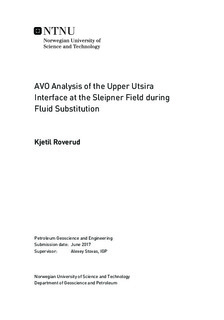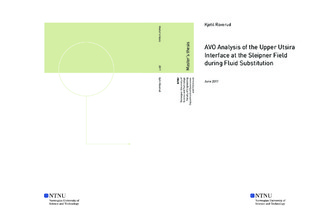| dc.description.abstract | Higher concentration of carbon dioxide (CO2) in the atmosphere has contributed to increased interest in subsurface carbon capture and storage (CCS) projects. Geologic storage of CO2 re- quires careful prior studies of geologic structures to prevent leakage. Further, repeated seismic surveys are required to monitor the evolution of the injected CO2. This study performs a theoretical sensitivity analysis of the amplitude versus offset (AVO) coefficients to examine their correlations with CO2 saturation. Also, the theoretical modeling is compared with seismic data to determine if the response post injection is detectable from seismic noise. The seismic data available is for a brine-filled formation. Different AVO methods are also evaluated in the thesis.
The area investigated in the study is the Sleipner field located in the middle of the Central North Sea. The field is a pioneer when it comes to CCS, where CO2 is injected into the Utsira formation. The formation consists of mainly unconsolidated sand with an overburden shale layer. In this study, AVO analyses of the upper Utsira interface from well log data and seismic data are performed prior to injection. Then a reservoir model investigates the response during fluid substitution between brine water and CO2.
The AVO response of the reservoir model is calculated using the Zoeppritz equation and the isotropic and anisotropic weak contrast approximation. The latter to determine the effect of including anisotropy in the AVO approximation. The result demonstrates that the effect is limited for the investigated interface. Further, the Zoeppritz equation and the isotropic approximation overlap for near offsets and diverge for far offsets. The effect of fluid substitution is well observed if the PP-wave reflection coefficient, Rpp, is plotted against the angle of incidence, θ. The trend is that the reflection coefficient becomes more negative as CO2 substitutes brine water in the Utsira formation.
Trends are also observed crossplotting the AVO terms; the intercept (R0), the gradient (G) and the curvature (K), respectively. The results show that the curvature term does not bring more valuable information as it is less sensitive to fluid substitution than the intercept and gradient terms. Crossplotting the intercept and gradient show that both terms decay strongly as CO2 is injected into the Utsira formation. Further, a loss of sensitivity is observed as the CO2 saturation increases. The result is that accurate determination of CO2 content for high saturations are challenging.
Lastly, the response from the reservoir model is superimposed to the AVO response for a brine-filled Utsira formation from seismic data. The response from the seismic data is the extracted upper Utsira interface from two seismic sections. The effect for both sections is that the quantitatively theoretical AVO response for a CO2 saturated formation generates a separate cluster away from the seismic response. This despite noise in the sections. The results show that the AVO method, in the area investigated, is sensitive to fluid substitution. The approach presented is expected to be applicable and valuable for CCS projects in the future. | |

